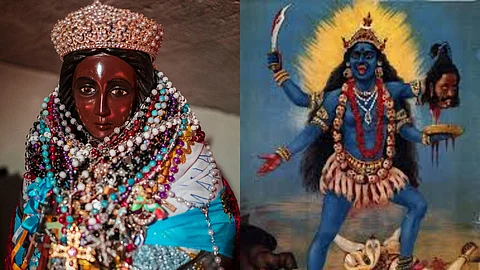
- HOMEGROWN WORLD
- #HGCREATORS
- #HGEXPLORE
- #HGVOICES
- #HGSHOP
- CAREERS
- ABOUT US
- CONTACT US

Her name is Sara-la-Kali — Sara the Black. Some say she was a slave woman who served the family of Christ; some say she was his daughter, conceived by Mary Magdalene in secret. Other legends link her to Kali, the dark-skinned Hindu goddess. Her shrine is in the Southern French seaside town of Saintes-Maries-de-la-Mer — the Saint Marys of the Sea — where the river Rhône meets the Mediterranean Sea. Every year in late May, thousands of Romani pilgrimage to the town to venerate and worship her in a ritual reminiscent of Hindu mother goddess worship. Her idol is draped in new clothes and taken to the sea to re-enact her arrival in Europe. Today, she is worshipped by the Romani the refugees, and new immigrants as the protector saint of the dispossessed, the displaced, the desperate, the offended, the travellers, and the needy.
However, despite Sara-la-Kali's popular veneration amongst Romani Catholics, the Roman Catholic Church does not consider her a Saint. According to Martina Petkova, the author of 'The Black Madonna', this is because the Romani — who constitute the majority of her worshippers — arrived in the Balkans and Europe at a time when the entire continent had calcified around Christianity and its dogmas. "God was a man, and he had a son who saved humanity from their sins," says Martina in her book. "There was no room in divinity for a feminine symbol. Mary, despite her being the Mother of Jesus Christ, was not officially canonized by the Catholic Church until 1933. (...) But in the old religions, Gods existed alongside Goddesses. And these Goddesses were very often depicted as black."
Kali was one of these old goddesses. When the nomadic Romani migrated from northwestern India to Europe in the 4th century CE, they still practiced some forms of Shaktism, or Hindu mother goddess worship. Rather than one punishing, angry male God who told you who is superior to whom and to blindly follow authority, their faith — similar to many pagan traditions and ancient faiths where Goddesses had a place in people’s consciousness — encouraged the Romani to have their own agency, intuitions, and wisdom. Their connection to the divine was direct, without intermediaries who claimed to speak on behalf of God.
In pre-humanism Europe, the Christians persecuted the Romani as "devil-worshippers" because of their religious beliefs. The Romani did not create Sara-la-Kali, but in their struggle to assimilate and fit within dogmatic European Catholic Christian society, they linked their mother goddess to the obscure figure of Saint Sarah. For the Romani, Sara-la-Kali came to embody resilience. In time, her origins as a Hindu Goddess was hidden in plain sight. Even the name Sara is also found in relation to mother goddesses like Durga and Kali in the 3rd-century Hindu scripture Durgasaptashati.
Today, Saint Sara the Black — the protector of the dispossessed — is called upon for protection, especially by those who live on the move, echoing the struggles of migrants and displaced people worldwide. Her annual festival in Saintes-Maries-de-la-Mer is a powerful testament to that faith and identity. As pilgrims carry her statue into the sea, their ritual procession symbolises not just the arrival of the Marys, but also the journey of the Romani people themselves and their dark-skinned mother goddess — crossing lands, preserving their culture, and honouring the saintly mother figure who watches over them.
If you enjoyed reading this, here's more from Homegrown:
Bonbibi - The Goddess Worshipped By Both Hindus And Muslims
The Hindu Goddess Worshipped By India's Transgender Community
An Exhibition At The Bengal Biennale Will Explore Kali's Permanence Across Art & Culture
